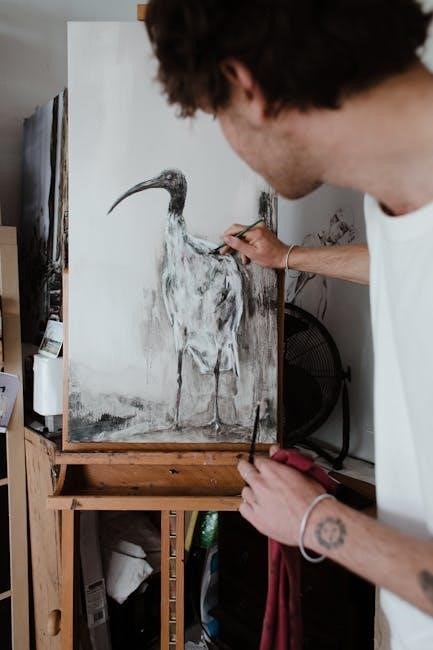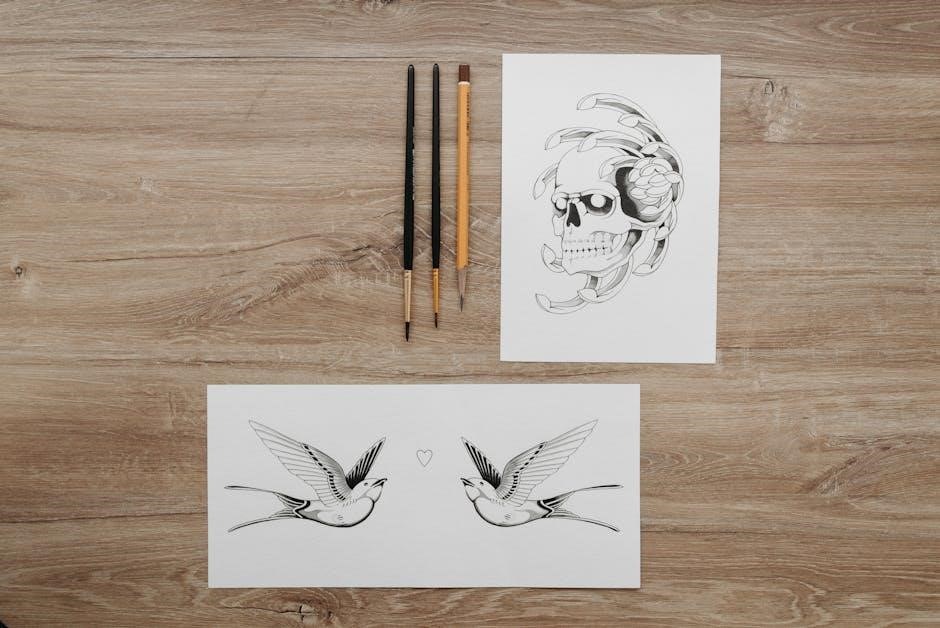This comprehensive guide by John Muir Laws offers a blend of artistic techniques and scientific understanding, helping enthusiasts master bird drawing while deepening their connection to nature.
Overview of John Muir Laws and His Approach to Bird Drawing
John Muir Laws, a renowned naturalist, educator, and artist, brings a unique blend of scientific knowledge and artistic skill to bird drawing. With degrees in conservation and resource studies, Laws emphasizes understanding bird anatomy and behavior to create accurate and expressive drawings. His approach encourages simplicity, breaking complex forms into basic shapes and focusing on essential details. Laws advocates for consistent practice and observation, making bird drawing accessible to all skill levels. His teachings highlight the connection between art and nature, inspiring learners to deepen their appreciation for the natural world through drawing.
The Importance of Understanding Bird Anatomy for Accurate Drawings
Understanding bird anatomy is fundamental for creating precise and lifelike drawings. By studying the skeleton, muscular system, and feather structure, artists can accurately capture the form, proportions, and movement of birds. This knowledge helps in rendering the intricate details of feathers, their growth patterns, and how they overlap. Anatomy provides the foundation for conveying the unique characteristics of each species, ensuring drawings are both realistic and visually compelling. It also enhances the ability to sketch birds in various poses and behaviors, making drawings more dynamic and expressive. This understanding transforms drawing from mere representation to a deeper connection with nature.

Understanding Bird Anatomy
Bird anatomy is a fascinating blend of structure and function, with lightweight skeletons, powerful muscles, and intricate feather systems designed for flight and survival, essential for realistic drawings.
The Skeleton and Muscular System of Birds
The skeleton of birds is uniquely adapted for flight, with lightweight, hollow bones and a robust structure that supports both strength and agility. The keel bone, or sternum, is a key feature, anchoring powerful flight muscles. Understanding the muscular system is equally important, as it reveals how birds move and maintain posture. The muscles are specialized for different functions, such as wing movement and tail steering. This anatomical knowledge is crucial for capturing the proportions and poses of birds accurately in drawings, helping artists create lifelike and dynamic representations of their subjects.
Feather Structure and How Feathers Grow
Feathers are one of the most complex and unique features of birds, with a structure that includes a central shaft, vanes, and tiny barbs. They grow from follicles in the skin, emerging in a specific sequence and overlapping to form a cohesive covering. Different types of feathers, such as contour, flight, and down feathers, serve distinct functions. Understanding their growth patterns and arrangement is essential for capturing their texture and form in drawings. Laws emphasizes studying how feathers overlap and insert into the body to create accurate, lifelike representations of birds.

Essential Techniques for Drawing Birds
Mastering basic shapes, proportions, and movement is key to capturing birds accurately. Understanding their anatomy and feather structure helps create realistic, dynamic drawings.
Basic Shapes and Proportions in Bird Drawing
Mastering basic shapes and proportions is foundational to drawing birds. Start with simple forms like spheres for heads, cylinders for bodies, and ovals for chests. Understanding the relationship between these shapes helps capture the bird’s structure. Proportions vary by species, so observing the balance of the body, tail, and beak is essential. Accurate proportions ensure your drawings look lifelike. Practice sketching these fundamental forms to build a strong foundation. This approach simplifies complex subjects and enhances your ability to draw birds confidently in the field or from reference photos.
Capturing Movement and Pose in Bird Sketches
Capturing the dynamic movement and pose of birds is key to creating lifelike sketches. Birds are constantly in motion, so understanding their anatomy and behavior helps convey energy. Use gesture sketches to quickly capture poses, focusing on the flow of lines and balance. Pay attention to how feathers and body structure shift with movement. Practice observing and drawing birds in action, whether they’re perched, flying, or foraging. Reference photos can aid in studying details, but field sketching helps you learn to depict motion intuitively. This practice enhances your ability to convey the vitality of birds in your art;
Drawing Feathers
Drawing feathers requires understanding their structure, growth patterns, and how they overlap. Techniques like layering and texture help create realistic feather details and movement in bird drawings.
Understanding Feather Types and Their Functions
Bird feathers vary in type and function, with flight feathers enabling movement, contour feathers defining shape, and down feathers providing insulation. Filoplumes aid in sensing. Each feather type has a distinct structure and growth pattern, essential for accurate drawing. Understanding how feathers overlap, grow, and insert into the body helps artists capture their texture and form. John Muir Laws emphasizes the importance of studying these details to create realistic and lifelike bird illustrations, ensuring each feather is drawn with precision and purpose.
Techniques for Rendering Feathers Accurately
Accurate feather rendering requires understanding their growth patterns, overlap, and texture. Use hatching and stippling to capture feather details, starting with the shaft and proceeding to the vanes. Begin with the largest feathers and build up layers, ensuring proper alignment. Pay attention to feather edges to convey softness or crispness. Practice drawing feathers in various lighting conditions to enhance depth and dimension. These techniques, as outlined in The Laws Guide to Drawing Birds, help create realistic and detailed feather textures, essential for lifelike bird illustrations.
Field Sketching Birds
Field sketching birds involves quickly capturing their movement and behavior in natural habitats. Use reference photos to refine details and ensure accuracy in your drawings.
Tips for Sketching Birds in Their Natural Habitat
Sketching birds in their natural habitat requires patience and observation. Start by noting their behavior and posture. Use quick gestures to capture movement and proportions. Pay attention to feather details and plumage patterns. Practice simplifying complex forms into basic shapes. Carry a field journal to record observations and refine your sketches later. Understanding bird anatomy beforehand enhances accuracy. Use reference photos to fill in details missed during live observations. Consistency is key—sketch regularly to improve your skills and connection with nature.
Using Reference Photos to Enhance Your Sketches
Reference photos are invaluable for refining bird sketches, especially for capturing intricate feather details and anatomical accuracy. They allow you to study poses and plumage patterns missed during field observations. However, they should complement, not replace, live sketching. Use photos to verify proportions, colors, and textures, ensuring your sketches remain lifelike. Combine photo references with field notes to create dynamic, accurate, and expressive bird drawings. This hybrid approach enhances your ability to depict birds realistically while maintaining the spontaneity of fieldwork.

Advanced Drawing Exercises
Advanced exercises include drawing prompts, gesture sketches, and detailed studies of feather textures and anatomical accuracy to refine your bird drawing skills and capture their essence effectively.
Practice Exercises to Improve Your Bird Drawing Skills
Practice exercises such as gesture sketches, contour drawing, and detailed studies of feathers and beaks help refine accuracy and capture bird anatomy. Start with quick sketches to grasp movement, then focus on precise shapes and textures. Use reference photos to study plumage and proportions. Experiment with different mediums like pencils and ink to explore techniques. Regular practice and observation are key to mastering bird drawing. These exercises, outlined in The Laws Guide to Drawing Birds, build confidence and skill, allowing you to depict birds with both artistry and scientific precision.
Using Drawing Prompts to Stay Consistent and Creative
Drawing prompts are a powerful tool to maintain consistency and spark creativity in bird drawing. They provide structured exercises, guiding artists to focus on specific aspects like feather textures or flight poses. These prompts encourage exploration of various techniques and mediums, fostering artistic growth. By setting clear goals, prompts help develop a daily drawing habit, essential for improving skills. They also inspire new perspectives, keeping the creative process fresh and engaging. Regular use of prompts, as suggested in The Laws Guide to Drawing Birds, ensures steady progress and keeps artists motivated to refine their craft.

Connecting Art and Nature
Drawing birds bridges the gap between creativity and the natural world, fostering a deeper appreciation for wildlife and the environment through observant and meaningful art.
How Drawing Birds Can Deepen Your Connection to the Natural World
Drawing birds acts as a bridge between creativity and nature, fostering a deeper appreciation for wildlife. By observing and sketching birds, you gain insight into their behavior, anatomy, and habitats, which enhances your connection to the environment. This practice encourages mindfulness, patience, and a sense of stewardship, transforming drawing into a tool for both art and conservation. The process of capturing birds on paper helps you slow down, notice details, and appreciate the beauty of nature, ultimately enriching your relationship with the world around you.
Using Journaling to Enhance Your Bird Drawing Experience
Journaling complements bird drawing by transforming it into a holistic, immersive experience. Recording observations, notes, and sketches in a journal enhances your ability to remember details and reflect on your artistic journey. It allows you to document behaviors, plumage variations, and habitats, providing a valuable reference for future drawings. Over time, your journal becomes a testament to your growth as an artist and naturalist, offering insights and inspiration. By combining text and visuals, you create a unique, personalized resource that enriches your connection to birds and the natural world.
Mastering bird drawing is a journey of artistry and nature connection. With dedication and practice, you’ll capture their beauty and essence, fostering a deeper appreciation for the natural world.
Final Tips for Mastering Bird Drawing
- Practice consistently to refine your skills and build confidence.
- Observe birds in their natural habitat to capture their essence.
- Use reference photos to study details and improve accuracy.
- Focus on capturing movement and pose for dynamic sketches.
- Stay patient and persistent, as mastery takes time.
- Leverage John Muir Laws’ guidebook for structured learning.
- Experiment with techniques to develop your unique style.
- Keep a journal to track progress and inspire creativity.
Inspiration and Motivation to Keep Drawing Birds
Drawing birds is not just about skill—it’s about connecting with nature and fostering curiosity. John Muir Laws’ guidance encourages artists to see the world with fresh eyes, finding beauty in every feather and flight. By embracing the process, you’ll grow both as an artist and as a naturalist. Celebrate small victories, like capturing a bird’s posture or feather texture, to stay motivated. Remember, every sketch is a step toward deeper understanding and appreciation. Let the joy of creation and the wonders of birds inspire you to keep drawing and learning.
